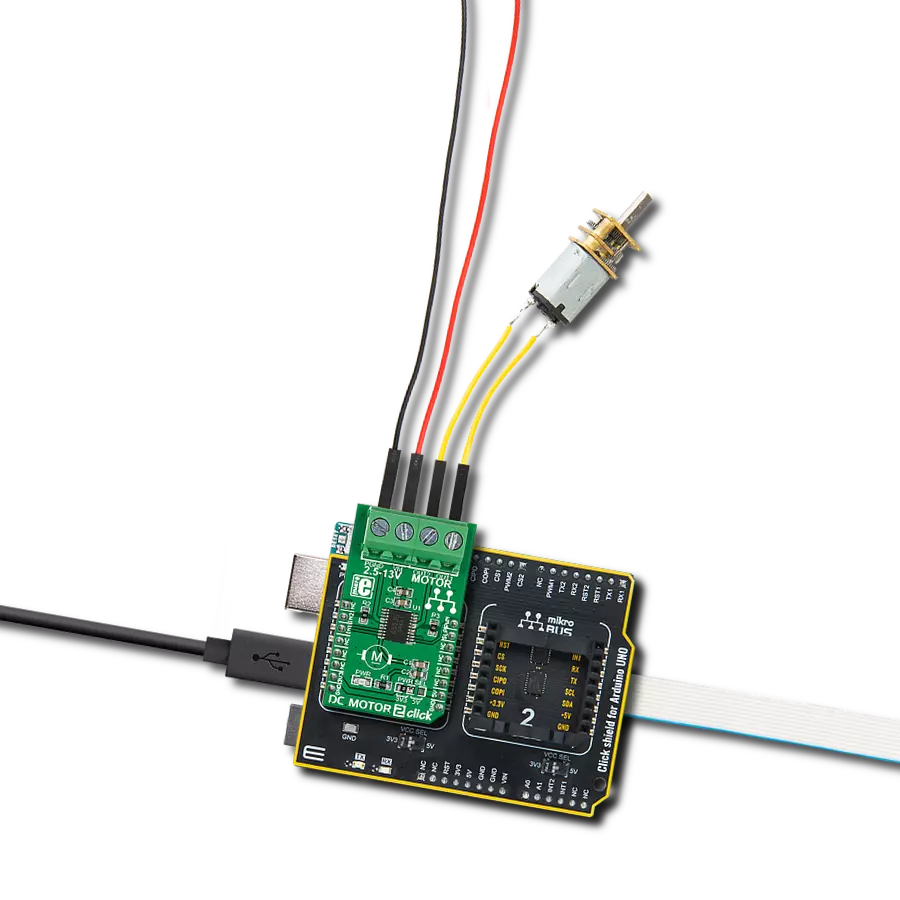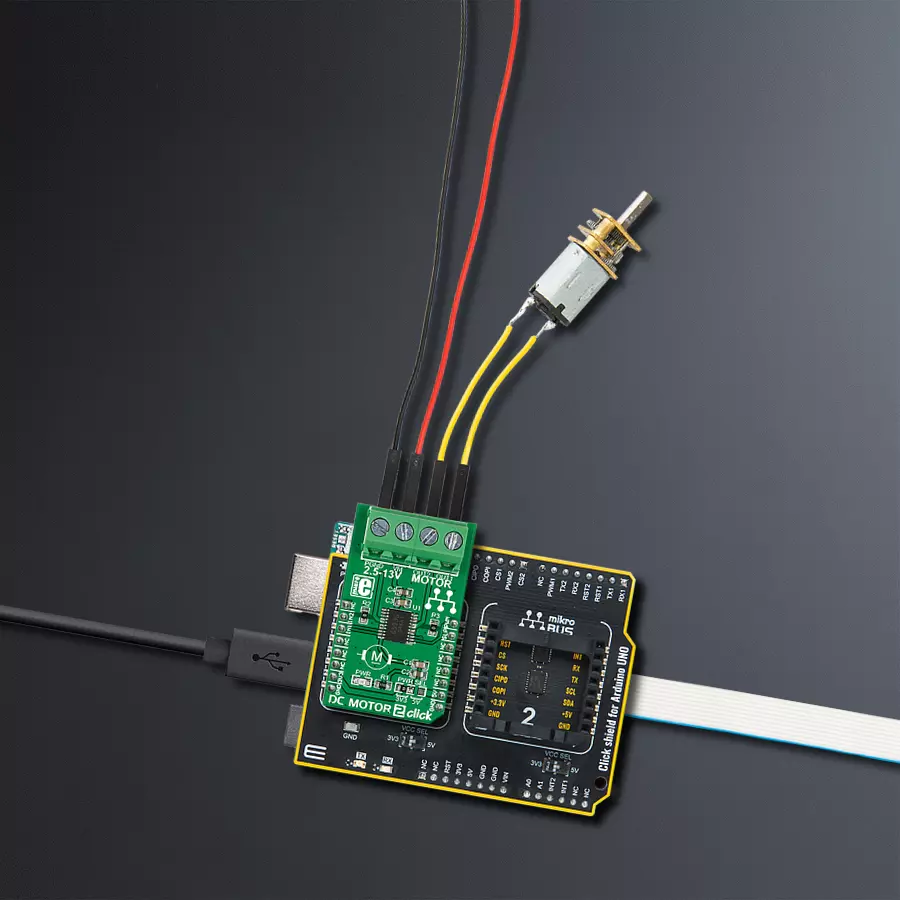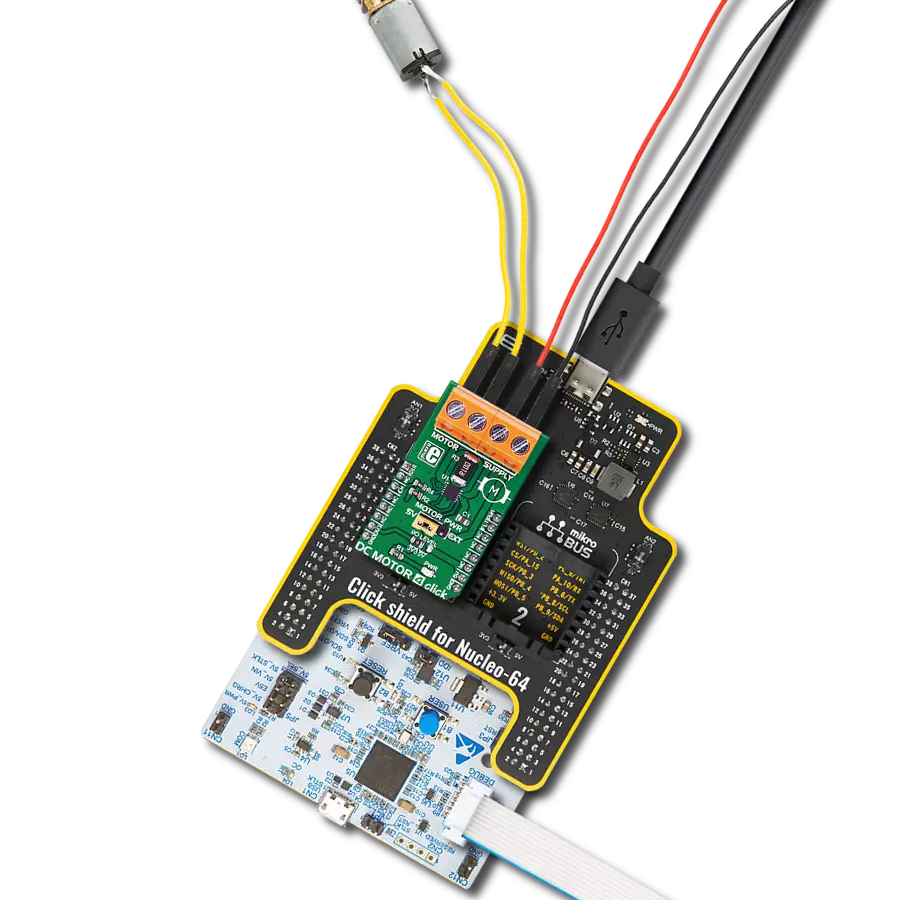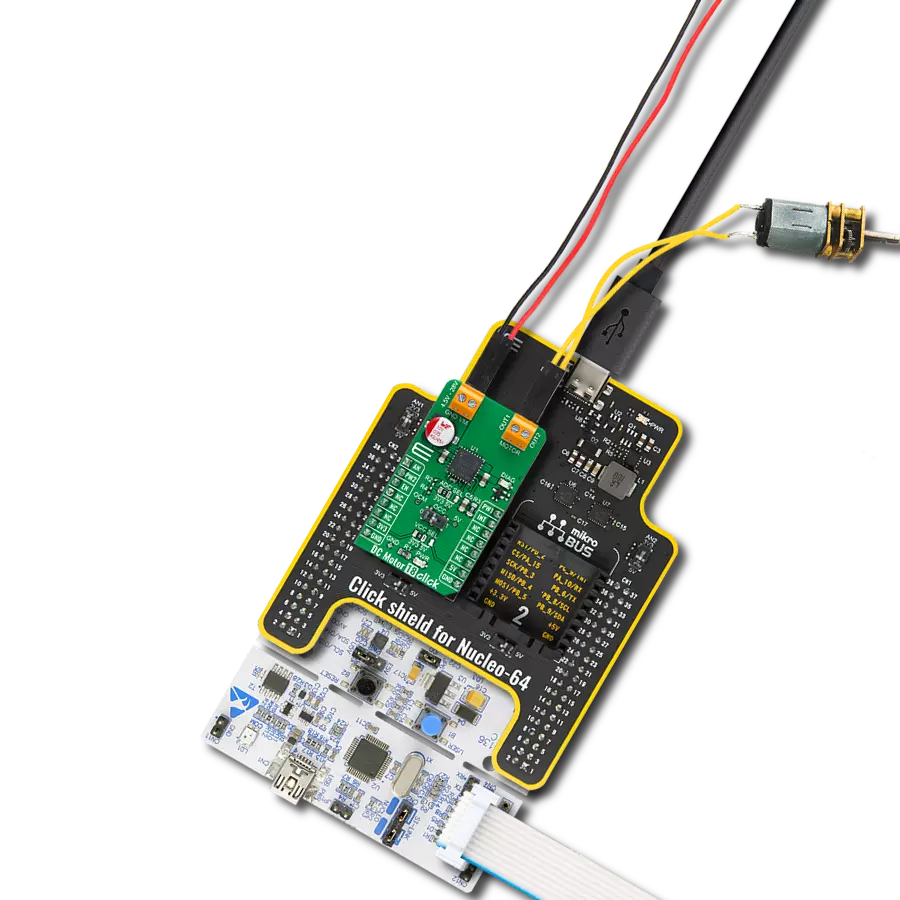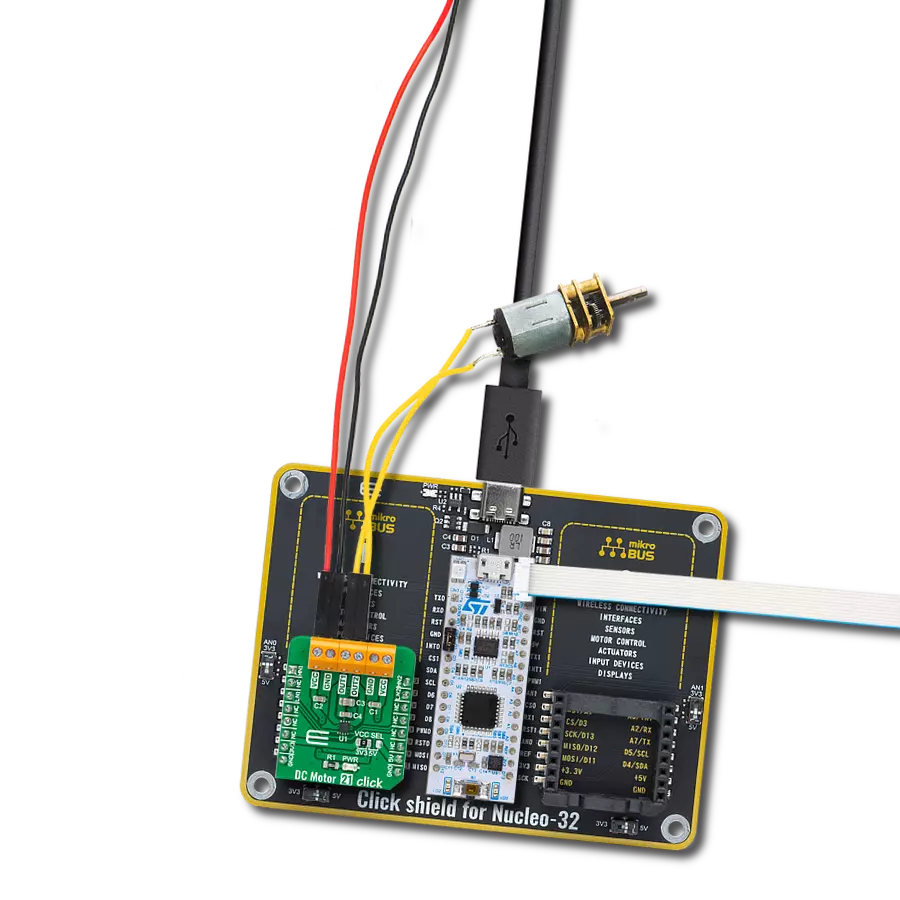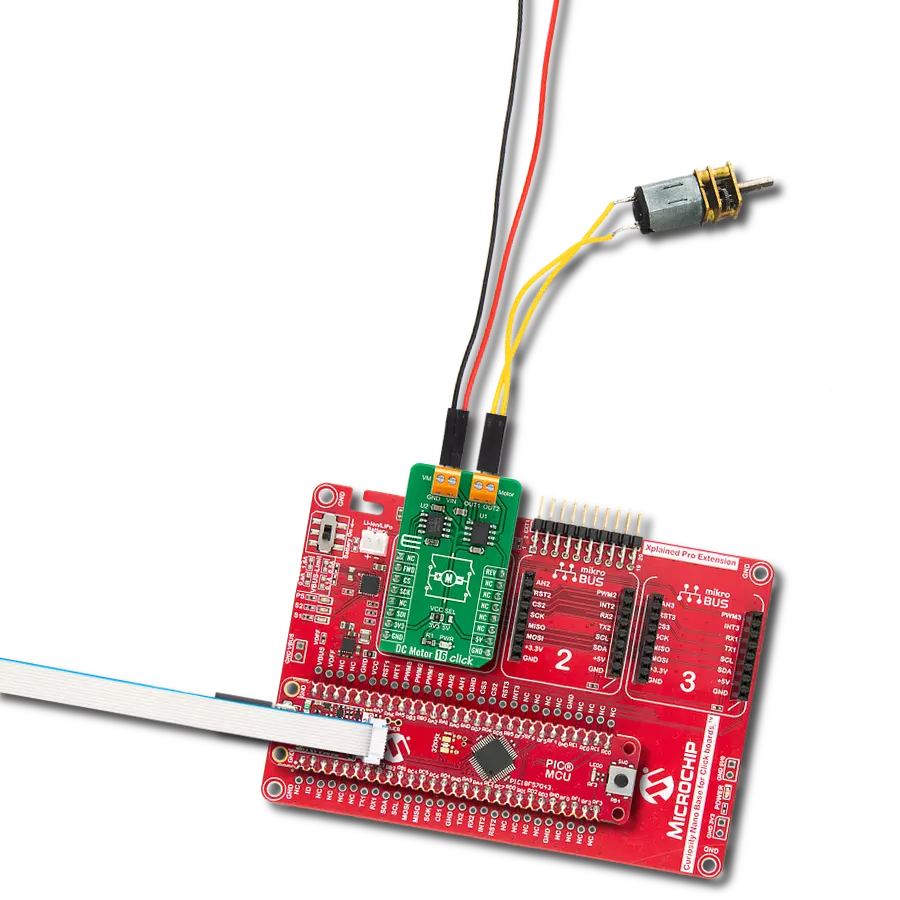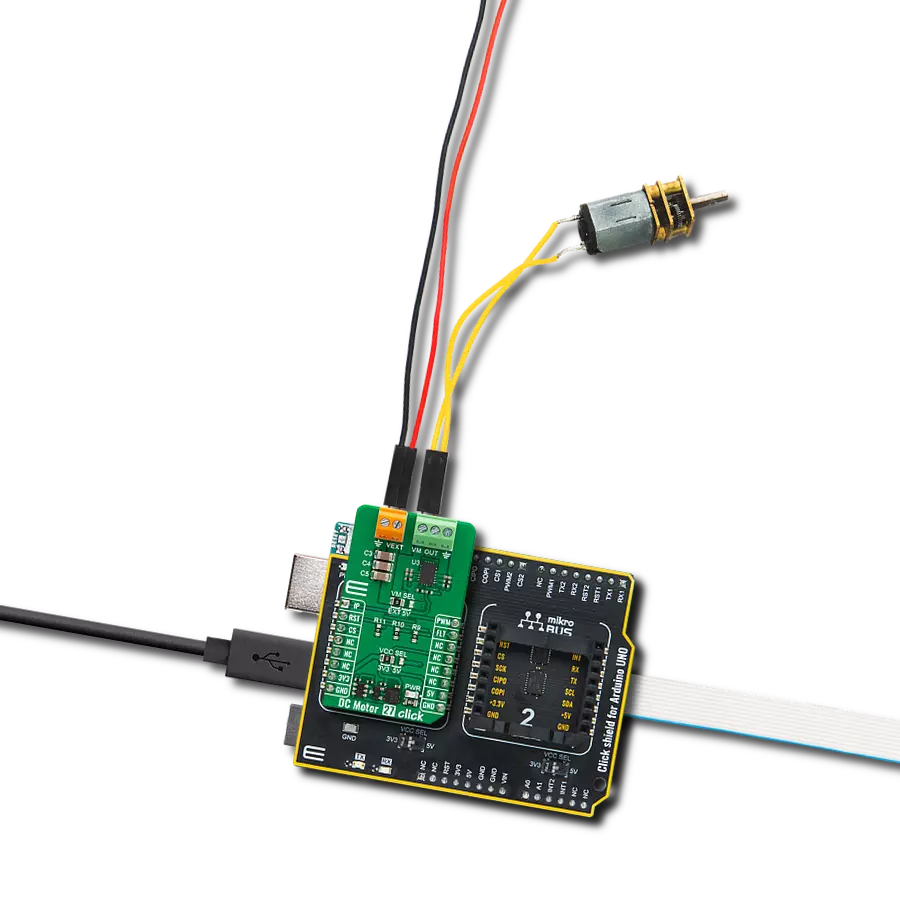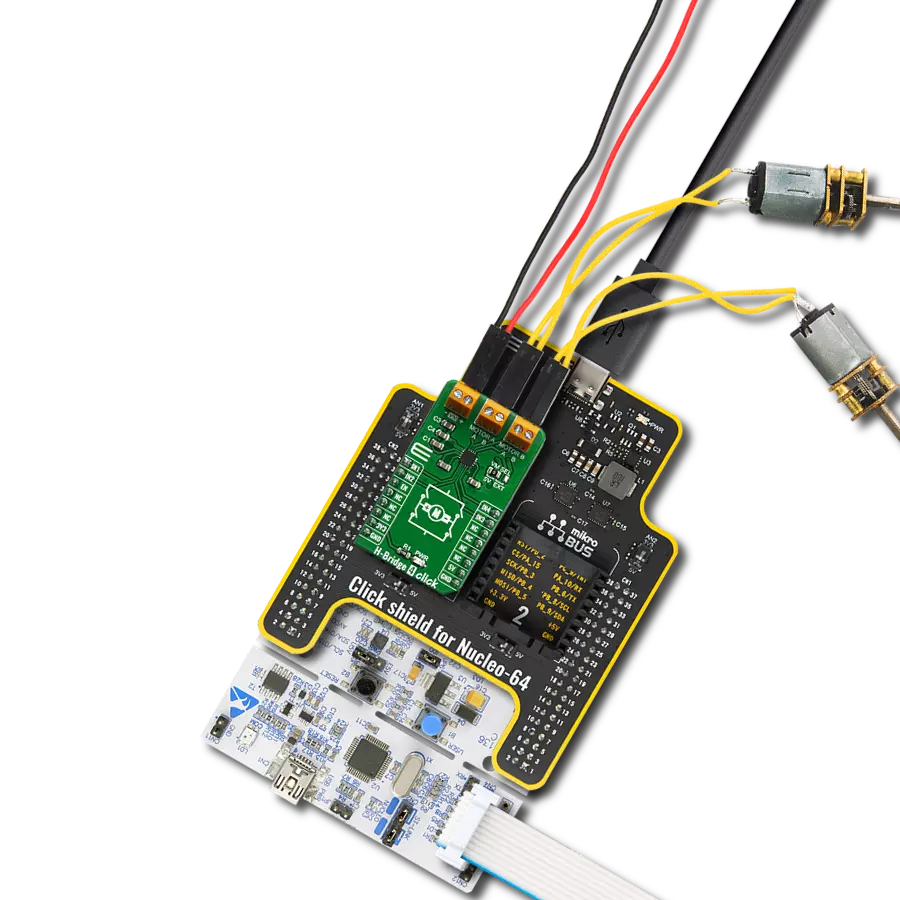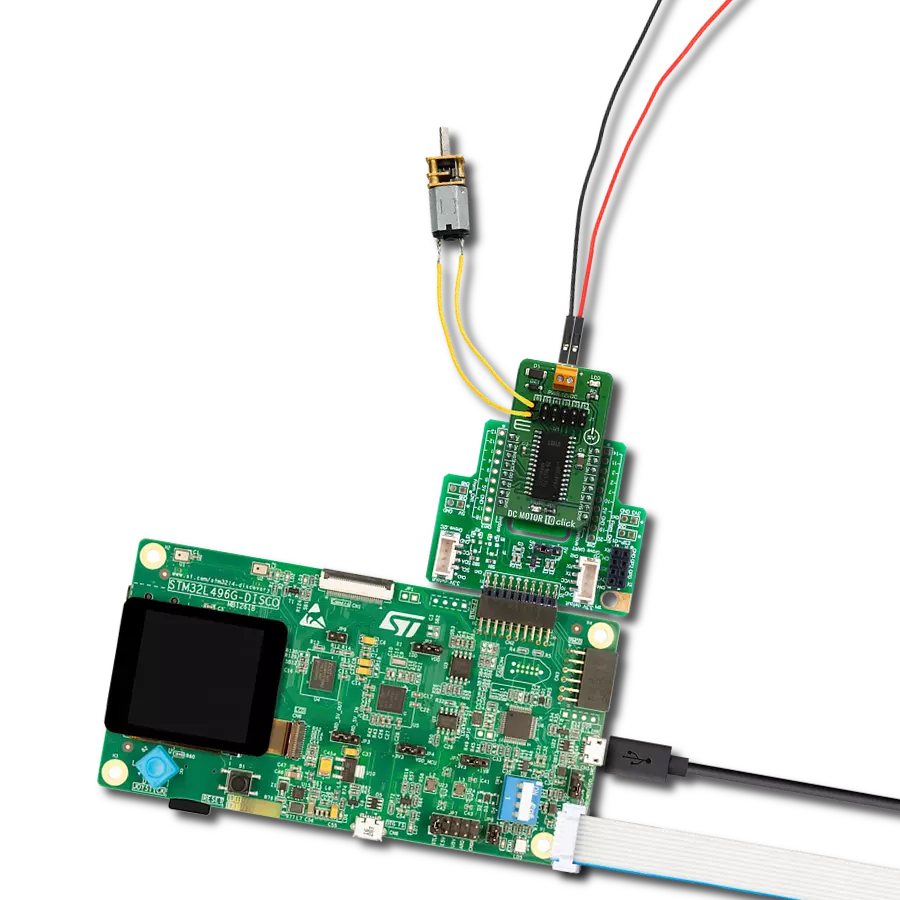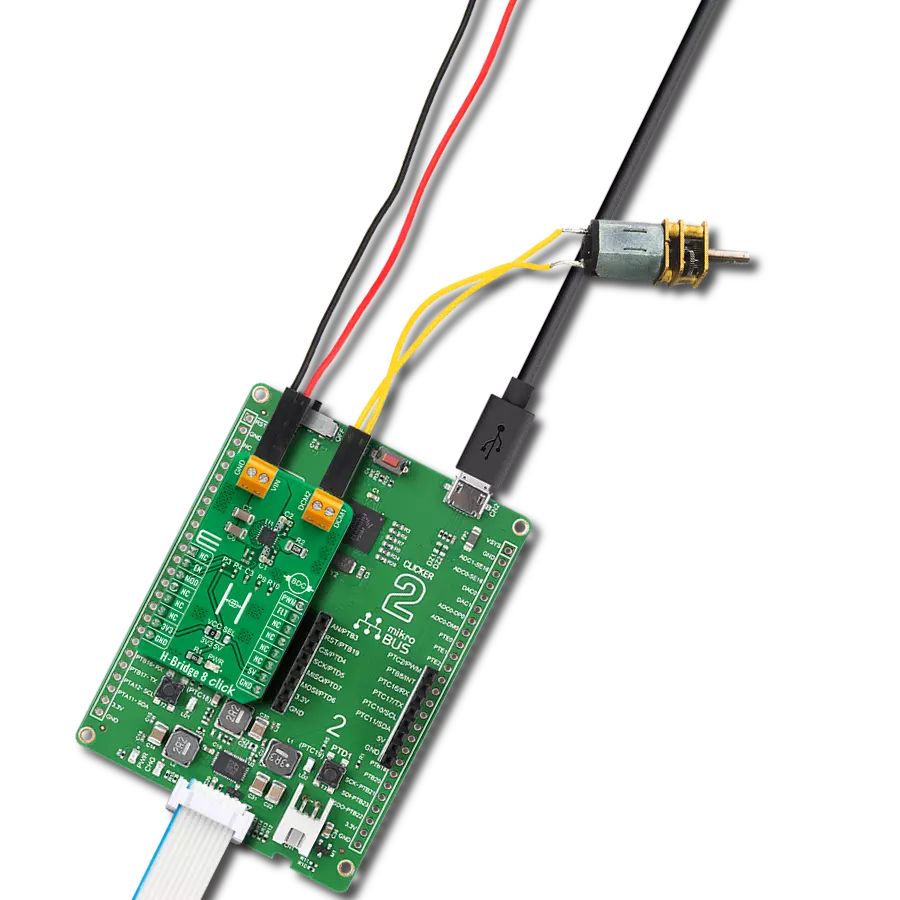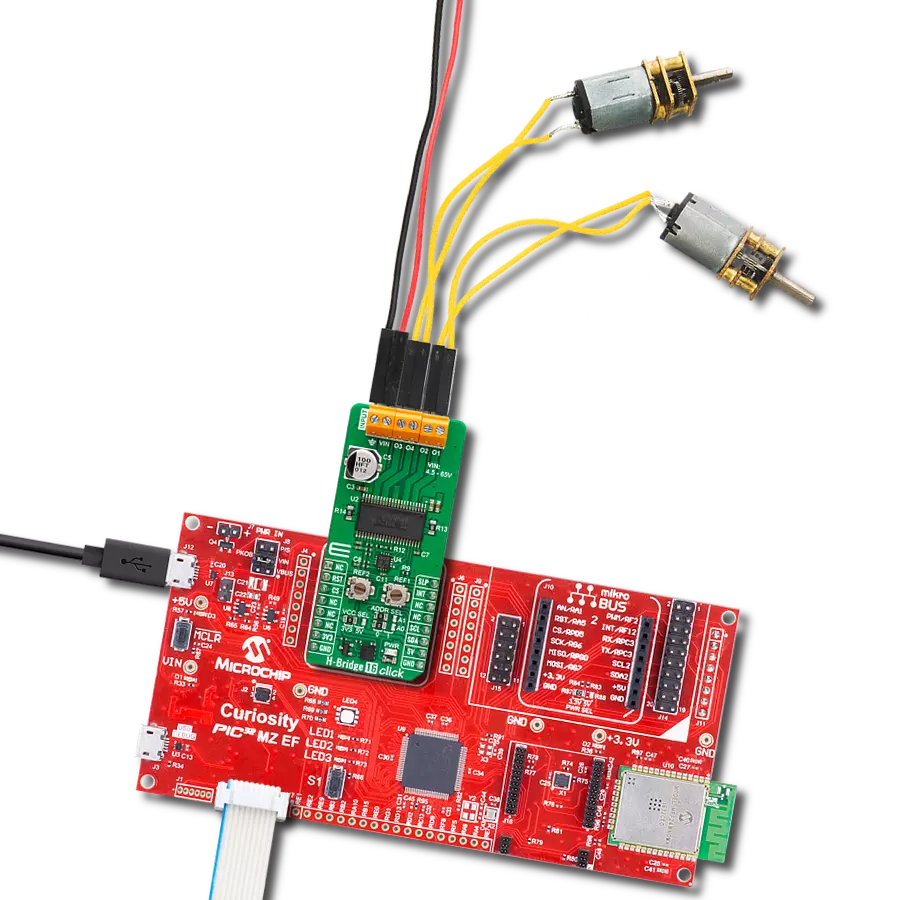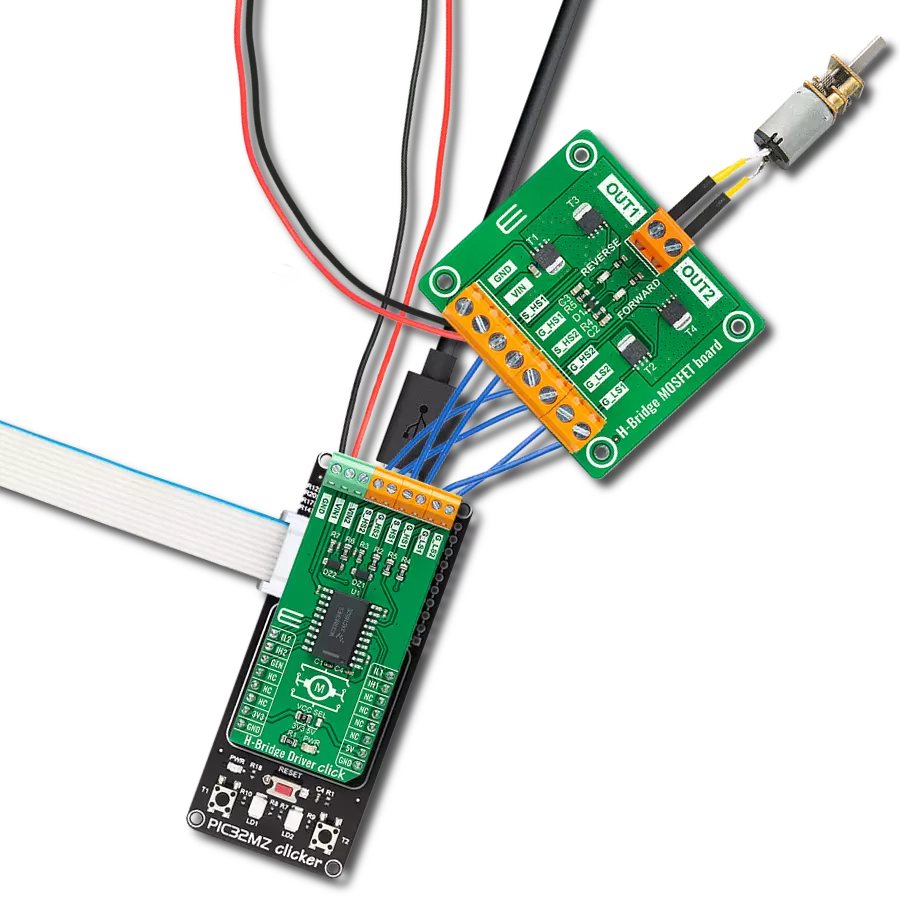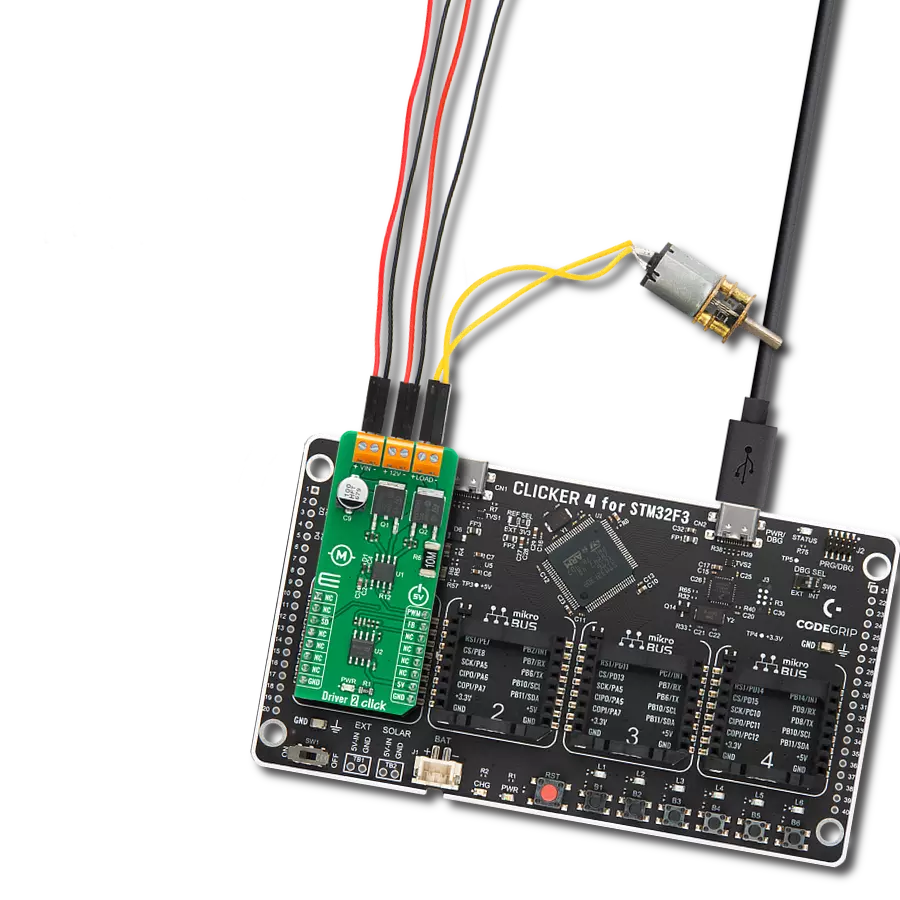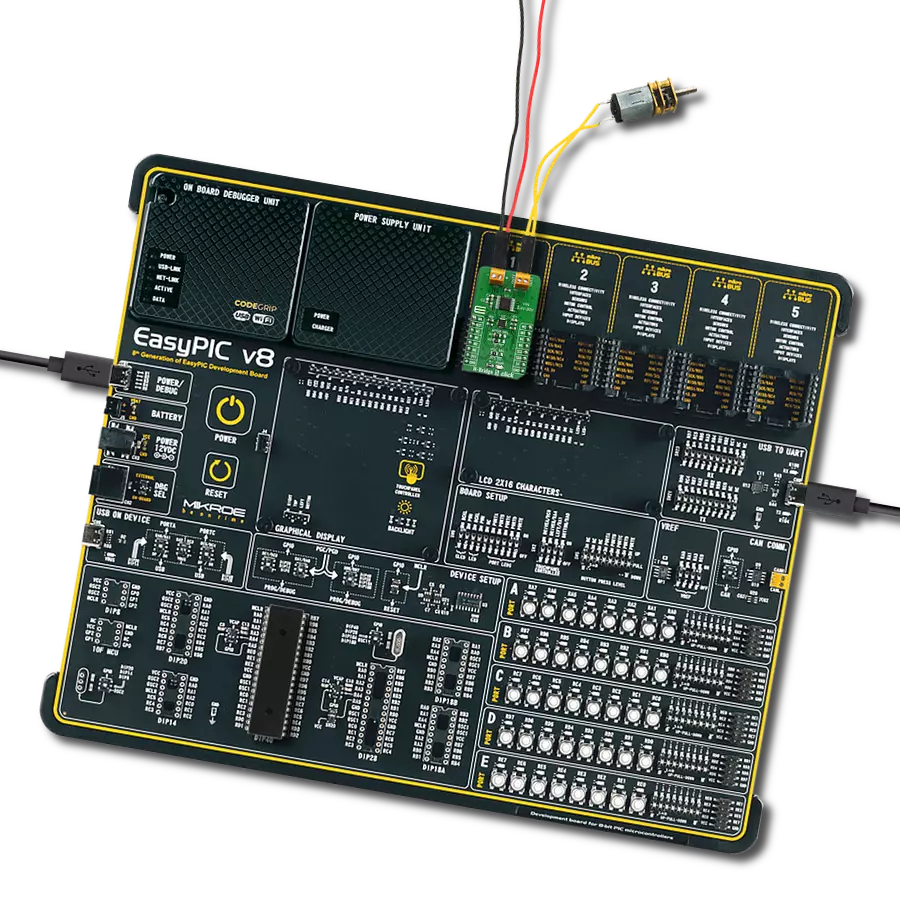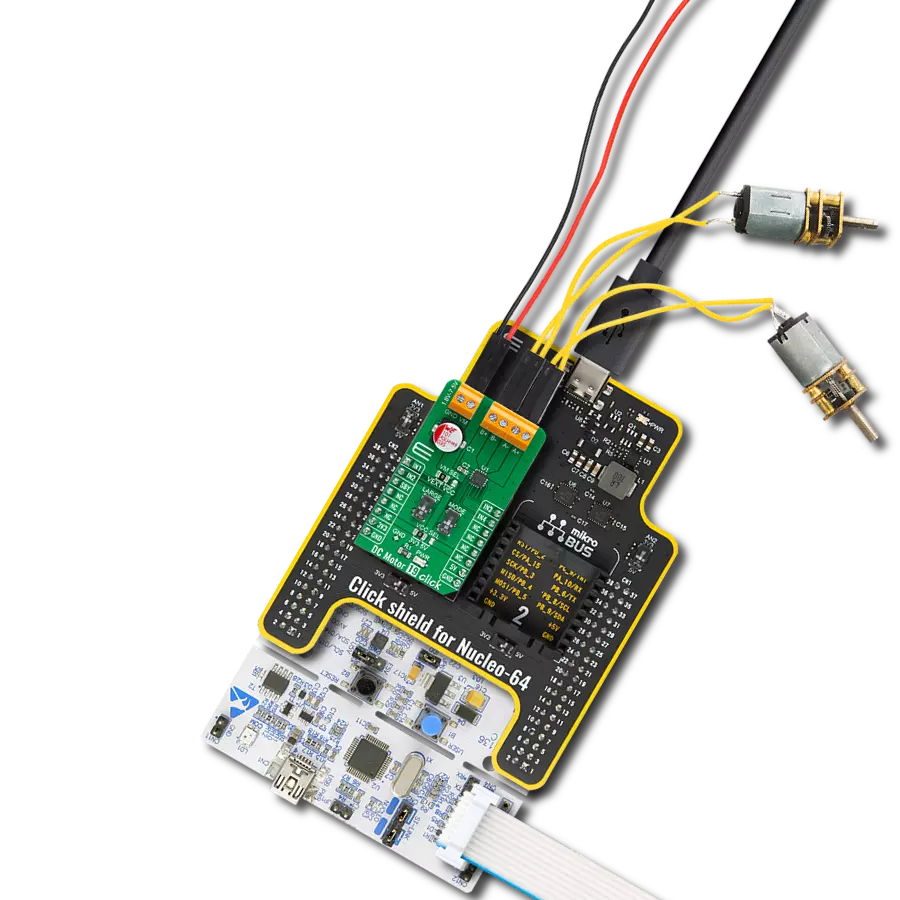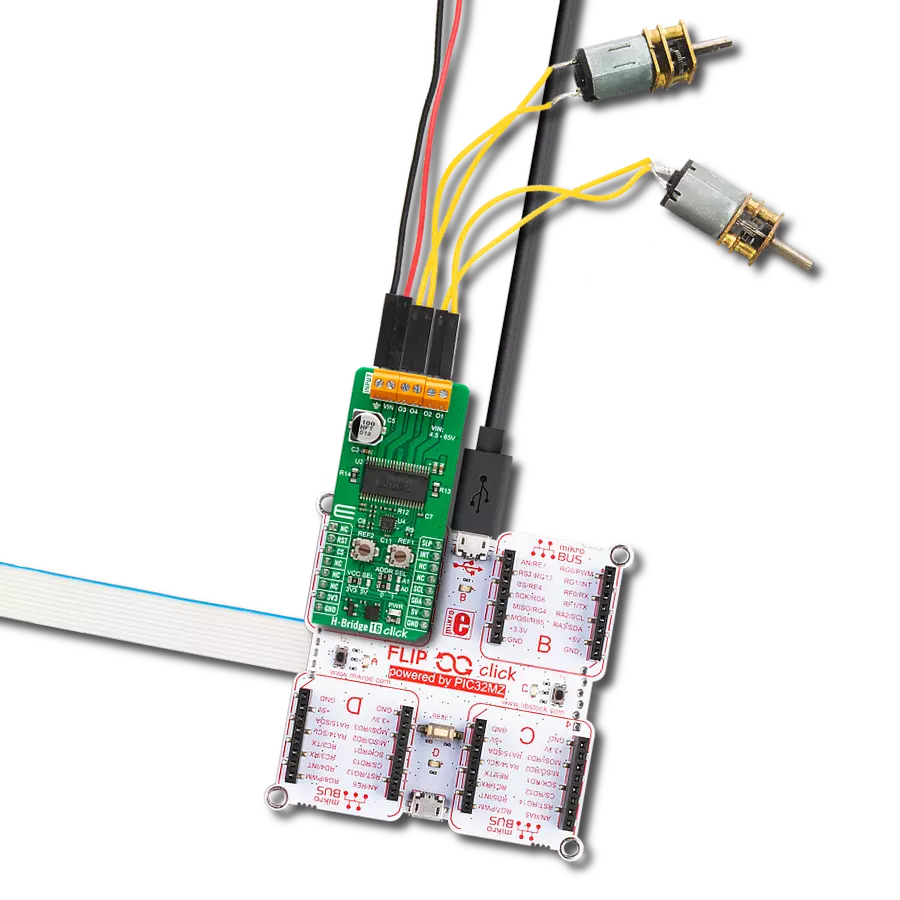Upgrade your engineering prowess, maximize efficiency, and unlock the "full-bridge" potential of your motors
A
A
Hardware Overview
How does it work?
DC MOTOR 2 Click is based on the TB6593FNG, full-bridge brushed DC motor driver from Toshiba Semiconductor. The TB6593FNG comes in a configuration with an output transistor in LD MOS structure with low on-resistance (0.35Ω typical with 5V power supply). It has a wide operating voltage range with an output current capacity of 1A maximum and control functions, including motor-related and built-in protection circuits such as thermal shutdown and low voltage detecting. This Click board™ is a PWM-controlled type with the ability for motor control through several pins of the mikroBUS™ socket. The PWM signal of the mikroBUS™ socket drives the motor while the IN1
and IN2 pins, routed on the CS and RST pins of the mikroBUS™ socket, provide binary direction signals that set the direction of the motor (clockwise or counterclockwise) or apply stop or short brake functions. Stop mode cuts off the power supply, so the motor continues spinning until it runs out of momentum, while a short break brings it to an abrupt stop. Alongside the PWM pin from the mikroBUS™ socket, used to drive a DC motor, this Click board™ also has a Standby pin labeled as SLP and routed to the INT pin of the mikroBUS™ socket to optimize power consumption used for power saving purposes. DC MOTOR 2 Click supports an external power supply
for the TB6593FNG, which can be connected to the input terminal labeled as VM and should be within the range of 2.5V to 13V, while the DC motor coils can be connected to the terminals labeled as OUT1 and OUT2. This Click board™ can operate with both 3.3V and 5V logic voltage levels selected via the PWR SEL jumper. This way, it is allowed for both 3.3V and 5V capable MCUs to use the communication lines properly. However, the Click board™ comes equipped with a library containing easy-to-use functions and an example code that can be used, as a reference, for further development.
Features overview
Development board
Arduino UNO is a versatile microcontroller board built around the ATmega328P chip. It offers extensive connectivity options for various projects, featuring 14 digital input/output pins, six of which are PWM-capable, along with six analog inputs. Its core components include a 16MHz ceramic resonator, a USB connection, a power jack, an
ICSP header, and a reset button, providing everything necessary to power and program the board. The Uno is ready to go, whether connected to a computer via USB or powered by an AC-to-DC adapter or battery. As the first USB Arduino board, it serves as the benchmark for the Arduino platform, with "Uno" symbolizing its status as the
first in a series. This name choice, meaning "one" in Italian, commemorates the launch of Arduino Software (IDE) 1.0. Initially introduced alongside version 1.0 of the Arduino Software (IDE), the Uno has since become the foundational model for subsequent Arduino releases, embodying the platform's evolution.
Microcontroller Overview
MCU Card / MCU
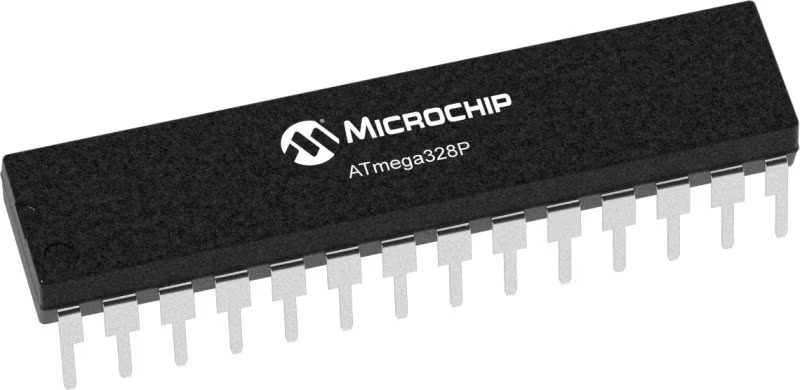
Architecture
AVR
MCU Memory (KB)
32
Silicon Vendor
Microchip
Pin count
28
RAM (Bytes)
2048
You complete me!
Accessories
Click Shield for Arduino UNO has two proprietary mikroBUS™ sockets, allowing all the Click board™ devices to be interfaced with the Arduino UNO board without effort. The Arduino Uno, a microcontroller board based on the ATmega328P, provides an affordable and flexible way for users to try out new concepts and build prototypes with the ATmega328P microcontroller from various combinations of performance, power consumption, and features. The Arduino Uno has 14 digital input/output pins (of which six can be used as PWM outputs), six analog inputs, a 16 MHz ceramic resonator (CSTCE16M0V53-R0), a USB connection, a power jack, an ICSP header, and reset button. Most of the ATmega328P microcontroller pins are brought to the IO pins on the left and right edge of the board, which are then connected to two existing mikroBUS™ sockets. This Click Shield also has several switches that perform functions such as selecting the logic levels of analog signals on mikroBUS™ sockets and selecting logic voltage levels of the mikroBUS™ sockets themselves. Besides, the user is offered the possibility of using any Click board™ with the help of existing bidirectional level-shifting voltage translators, regardless of whether the Click board™ operates at a 3.3V or 5V logic voltage level. Once you connect the Arduino UNO board with our Click Shield for Arduino UNO, you can access hundreds of Click boards™, working with 3.3V or 5V logic voltage levels.
DC Gear Motor - 430RPM (3-6V) represents an all-in-one combination of a motor and gearbox, where the addition of gear leads to a reduction of motor speed while increasing the torque output. This gear motor has a spur gearbox, making it a highly reliable solution for applications with lower torque and speed requirements. The most critical parameters for gear motors are speed, torque, and efficiency, which are, in this case, 520RPM with no load and 430RPM at maximum efficiency, alongside a current of 60mA and a torque of 50g.cm. Rated for a 3-6V operational voltage range and clockwise/counterclockwise rotation direction, this motor represents an excellent solution for many functions initially performed by brushed DC motors in robotics, medical equipment, electric door locks, and much more.
Used MCU Pins
mikroBUS™ mapper
Take a closer look
Click board™ Schematic

Step by step
Project assembly
Software Support
Library Description
This library contains API for DC MOTOR 2 Click driver.
Key functions:
dcmotor2_spin_counter_clockwise- This function sets the IN1/IN2 pins to 0/1 and makes the motor spin counter clockwise.dcmotor2_spin_clockwise- This function sets the IN1/IN2 pins to 1/0 and makes the motor spin clockwise.dcmotor2_pull_brake- This function sets the IN1/IN2 pins to 1/1 and forces the motor to break.dcmotor2_stop_motor- This function sets the IN1/IN2 pins to 0/0 and stops the motor completely.
Open Source
Code example
The complete application code and a ready-to-use project are available through the NECTO Studio Package Manager for direct installation in the NECTO Studio. The application code can also be found on the MIKROE GitHub account.
/*!
* \file
* \brief DcMotor2 Click example
*
* # Description
* This library contains API for the DC Motor 2 Click driver.
* This example showcases how to initialize and use the DC Motor 2 Click. The Click contains a
* Driver IC for DC motors which can spin the motor clockwise, counter-clockwise, break it and
* completely stop the motor. The example needs a DC motor and a power supply in order to work.
*
* The demo application is composed of two sections :
*
* ## Application Init
* This function initializes and configures the logger and Click modules.
*
* ## Application Task
* This is an example that demonstrates the use of the DC Motor 2 Click board.
* DC Motor 2 Click communicates with register via PWM interface.
* It shows moving in the Clockwise direction from slow to fast speed
* and from fast to slow speed, then rotating Counter Clockwise,
* Results are being sent to the Usart Terminal where you can track their changes.
*
* \author Nikola Peric
*
*/
// ------------------------------------------------------------------- INCLUDES
#include "board.h"
#include "log.h"
#include "dcmotor2.h"
// ------------------------------------------------------------------ VARIABLES
static dcmotor2_t dcmotor2;
static log_t logger;
uint8_t dcmotor_direction = 1;
// ------------------------------------------------------ APPLICATION FUNCTIONS
void application_init ( )
{
log_cfg_t log_cfg;
dcmotor2_cfg_t cfg;
/**
* Logger initialization.
* Default baud rate: 115200
* Default log level: LOG_LEVEL_DEBUG
* @note If USB_UART_RX and USB_UART_TX
* are defined as HAL_PIN_NC, you will
* need to define them manually for log to work.
* See @b LOG_MAP_USB_UART macro definition for detailed explanation.
*/
LOG_MAP_USB_UART( log_cfg );
log_init( &logger, &log_cfg );
log_info( &logger, "---- Application Init ----" );
Delay_ms ( 100 );
// Click initialization.
dcmotor2_cfg_setup( &cfg );
DCMOTOR2_MAP_MIKROBUS( cfg, MIKROBUS_1 );
Delay_ms ( 100 );
dcmotor2_init( &dcmotor2, &cfg );
dcmotor2_pwm_start( &dcmotor2 );
Delay_ms ( 1000 );
log_info( &logger, "---- Application Task ----" );
}
void application_task ( )
{
static int8_t duty_cnt = 1;
static int8_t duty_inc = 1;
float duty = duty_cnt / 10.0;
if ( dcmotor_direction == 1 )
{
dcmotor2_pull_brake ( &dcmotor2 );
dcmotor2_spin_clockwise ( &dcmotor2 );
log_printf( &logger, "> CLOCKWISE <\r\n" );
dcmotor2_enable_motor ( &dcmotor2 );
}
else
{
dcmotor2_pull_brake ( &dcmotor2 );
dcmotor2_spin_counter_clockwise ( &dcmotor2 );
log_printf( &logger, "> COUNTER CLOCKWISE <\r\n" );
dcmotor2_enable_motor ( &dcmotor2 );
}
dcmotor2_set_duty_cycle ( &dcmotor2, duty );
log_printf( &logger, "> Duty: %d%%\r\n", ( uint16_t )( duty_cnt * 10 ) );
Delay_ms ( 500 );
if ( 10 == duty_cnt )
{
duty_inc = -1;
}
else if ( 0 == duty_cnt )
{
duty_inc = 1;
if ( dcmotor_direction == 1 )
{
dcmotor_direction = 0;
}
else if ( dcmotor_direction == 0 )
{
dcmotor_direction = 1;
}
}
duty_cnt += duty_inc;
}
int main ( void )
{
/* Do not remove this line or clock might not be set correctly. */
#ifdef PREINIT_SUPPORTED
preinit();
#endif
application_init( );
for ( ; ; )
{
application_task( );
}
return 0;
}
// ------------------------------------------------------------------------ END
Additional Support
Resources
Category:Brushed
